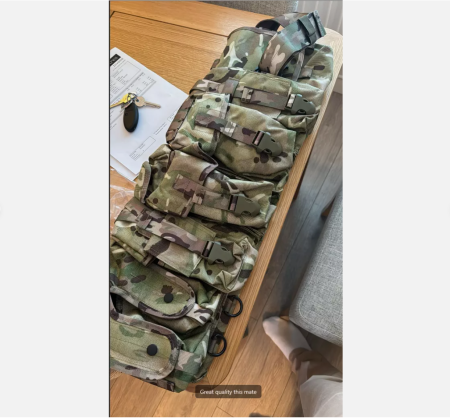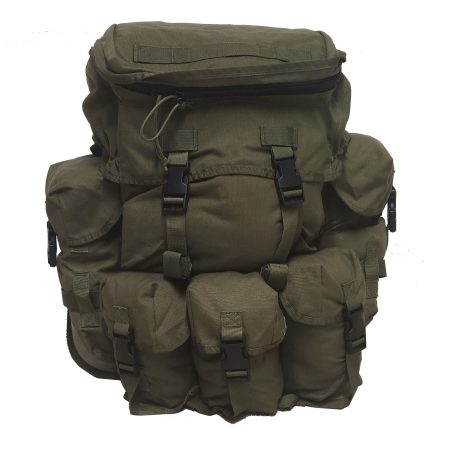In the dynamic world of modern warfare, camouflage plays a crucial role in ensuring the safety and effectiveness of military personnel. Enter MTP aka Multi Terrain Pattern, a revolutionary camouflage design that adapts seamlessly across various landscapes.
The unique pattern of Multi Terrain Pattern not only enhances concealment but also represents a significant evolution in tactical gear for British forces. Let’s take a closer look at the MTP and its impact on modern battlefield operations and delve deeper into MTP, exploring its history, advantages, and impact on British forces operating in diverse environments around the globe.
Multi Terrain Pattern
The Multi Terrain Pattern (MTP) is a cutting-edge camouflage design employed by the British Army. Crafted to provide optimal concealment, MTP features an array of colors and shapes that mimic natural environments. This adaptability ensures soldiers remain undetected across various terrains.
Developed through extensive research, the Multi Terrain Pattern pattern combines earthy tones with splotches that break up a soldier’s outline. Whether in forests, deserts, or urban settings, MTP enhances visibility reduction against multiple backgrounds.
What sets MTP apart is its versatility; it was specifically engineered for modern combat scenarios where environments can change rapidly. Soldiers equipped with this uniform can transition seamlessly from one landscape to another without compromising their stealth capabilities.
The Multi Terrain Pattern (MTP) was a revolutionary camouflage design adopted by the British Army. Its primary purpose is to enhance concealment across various landscapes and environments.
MTP combines colors and shapes that mimic natural patterns found in diverse terrains. This versatility allows soldiers to blend seamlessly into both urban settings and rural landscapes, making it an essential tool for modern warfare.
Unlike previous designs, MTP was created with input from troops deployed in real combat situations. Their experiences shaped its development, ensuring that it meets the demands of contemporary military operations.
As conflicts evolve, so do the needs for effective camouflage. MTP stands as a testament to this ongoing quest for better concealment solutions on today’s battlefields.
History and development of MTP
The Multi Terrain Pattern (MTP) emerged from the need for a versatile camouflage solution in modern warfare. Developed by the British Army, it was officially adopted in 2010 to replace older patterns that struggled with adaptability.
The design process involved extensive research and testing across various environments. Early prototypes were trialed by soldiers in diverse settings, from urban landscapes to dense forests.
This feedback loop was crucial. It enabled designers to refine MTP’s color palette and pattern intricacies, ensuring effectiveness across multiple terrains.
As conflicts evolved, so did the requirements for military gear. MTP reflects an understanding of the modern battlefield’s complexities—where soldiers face challenges in deserts, jungles, and everything in between.
The result is a highly functional camouflage that enhances concealment while maintaining operational readiness for British Forces around the globe.
Advantages of MTP over previous camouflage patterns
The Multi Terrain Pattern (MTP) offers several advantages that set it apart from earlier camouflage designs. Its versatility is one of its strongest points. MTP blends seamlessly into various environments, whether urban settings, woodlands, or arid landscapes.
Unlike older patterns like DPM, which were more limited in application, MTP incorporates a range of colors and shapes. This diversity enhances the ability to break up outlines effectively.
Another significant benefit is its modern design principles. Developed with input from extensive field testing, MTP reflects contemporary understanding of visual perception and environmental interaction.
Additionally, the fabric technology used in MTP ensures better durability and comfort for soldiers on the ground. It resists fading and wear over time while maintaining effective concealment properties across different terrains.
How MTP works in different terrains and environments
The Multi Terrain Pattern (MTP) is designed for versatility. Its color palette blends seamlessly with various landscapes, from dense woodlands to arid deserts.
In woodland areas, the greens and browns in MTP help soldiers merge with foliage. The pattern mimics natural shadows, obscuring movement against tree trunks and underbrush.
When deployed in urban settings, the flexible design adapts well among concrete structures. The mixed tones break up outlines effectively amidst buildings and debris.
On rocky terrains or sandy environments, MTP still excels. The subtle variations in color allow personnel to remain concealed against both light and dark surfaces.
This adaptability makes MTP a crucial asset for British forces operating globally. It enhances concealment across diverse operational theaters while maintaining effectiveness on the modern battlefield.
The future of MTP and potential advancements in military camouflage technology
The future of the Multi Terrain Pattern (MTP) looks promising as technology continues to advance. Innovations in materials and design are paving the way for more effective camouflage solutions.
Researchers are exploring adaptive camouflage systems that can change color and pattern in real-time, blending seamlessly into various environments. This dynamic approach could revolutionize concealment on the battlefield.
Moreover, advancements in 3D printing may allow for custom patterns tailored to specific missions or terrains. Such flexibility would enhance operational effectiveness significantly.
Additionally, integrating smart textiles with sensors could provide soldiers with crucial environmental feedback while maintaining stealth.
As military forces worldwide invest in these technologies, MTP will likely evolve further, ensuring British Army personnel remain one step ahead of adversaries. The quest for superior concealment is an ongoing journey filled with exciting possibilities





